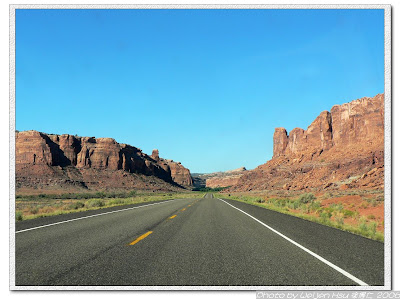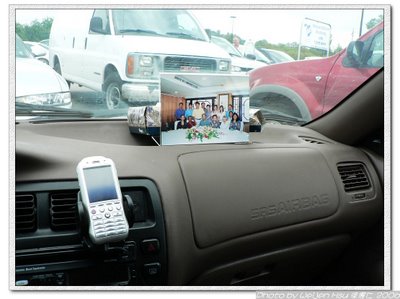Moab was the biggest town I had seen in the past five days. It provided plenty choices of hotels/motels. After comparing the prices, again I settled with the Motel 6. I drove around the town for a change of scene after traveling in the back country of the nation for almost one week. When I came across this intersection, I realized it was the first red signal I saw for the whole week. I took a picture to mark my reentry to the modern life.
 I drove around on the streets of Moab and finally decided to have a sneak peak of the Arches National Park before the sunset. The park is so close to the town that makes Moab a perfect location for its visitors. The entrance of the park sits quietly at a branch off the US-191 highway. It is so modest that it becomes a bit of surprise when people reveal all the beautiful scenery lies behind it.
I drove around on the streets of Moab and finally decided to have a sneak peak of the Arches National Park before the sunset. The park is so close to the town that makes Moab a perfect location for its visitors. The entrance of the park sits quietly at a branch off the US-191 highway. It is so modest that it becomes a bit of surprise when people reveal all the beautiful scenery lies behind it.There is an uphill climb after passing the park entrance and the newly built visitor center at the crossroad. As I climbed upward, I left behind the common world and got ready to enter the naturally made wonderland. The mother nature not only creates the magnificent Arches national park, but also prepares the stage so well that it is hard to believe everything is natural.
 Driving up-hill anxiously to know what's hidden on the other side of the cliff...
Driving up-hill anxiously to know what's hidden on the other side of the cliff... Half-way up, looking down at the park entrance gate and the visitor center at the foot of the hill. US-191 highway on the left.
Half-way up, looking down at the park entrance gate and the visitor center at the foot of the hill. US-191 highway on the left. Finally reached the top of the plateau. It was time to explore.
Finally reached the top of the plateau. It was time to explore.Once I reached the top of the plateau, the first thing to greet me was the "park avenue", a wide-open valley with high rising cliffs on both side. It should be a very nice walk through the valley, but I had more to do for the very limited time. I held back my urge for another walk and drove pass the park avenue.
 Three giant stones resembling the shape of sages (It has a name I couldn't remember) at the Park Avenue.
Three giant stones resembling the shape of sages (It has a name I couldn't remember) at the Park Avenue.
 Three giant stones resembling the shape of sages (It has a name I couldn't remember) at the Park Avenue.
Three giant stones resembling the shape of sages (It has a name I couldn't remember) at the Park Avenue.I followed the road in the park, passing by the Balanced Rock and arrived at the windows section. This place got the name due to the many openings on the stone cliff around the area. I followed a ranger's suggestion to come here first. He told me this would be a nice place if I want to take some pictures of the stars, something I wanted to do for days but couldn't because I woke up early these days and got too tired to stay in the parks until late. I got maybe one hour before dark, so I decided to walk around the place first.
The first thing I saw here is a big opening in the middle of a cliff, just like someone has punched through a thin layer of styrofoam board. I know it is 100% natural, but that is really hard to believe. The opening is huge, so the term "arch" is really the best to describe it. When I came close to the arch, I saw a handful of other tourists there, so I took another picture, using them as a scale to mark how large the arch is.
I further walked around the area and checked out the other "windows". They vary widely in sizes and shapes, and the diversity makes the whole section very interesting to walk through. Obviously, some arches are older than the other. When I walked around, I felt like walking through a special exhibition in an art gallery. All the pieces displayed are unique yet tightly coupled to a unified theme. With every turn I made, there were more to gaze at with amazement, and more pictures to take... I ended up shooting most of the openings I could discover in the section.
 These are the future windows in work.
These are the future windows in work.
 A large window next to a small one.
A large window next to a small one.
 Windows at the second floor....
Windows at the second floor....
 There are so many of them, but each is unique.
There are so many of them, but each is unique.
Finally I came back to sit underneath the first arch I saw, waiting for the nightfall. All the tourists were gone, and I could hear nothing but the breeze blowing across the land. I sit there quietly and tried not to think much other than just feeling myself mystically blend into the nature surrounding me. I stared at the wilderness underneath the hill as the darkness gradually took over. It was a slow but persistent process. I just sit silently there, trying to feel every second of it. This was some exercise I thought of on the spot, and it turned out really not easy since I am so used to the fast-paced life in the modern era. I felt impatient from time to time, although it was not really a long time I waited.
Finally, when it was dark enough, I realized it was not my night.... It was cloudy and no stars to be seen. I had to give up the plan of taking some nice pictures of the stars, and turned back to my hotel. This turned out to be the biggest disappointment during the trip. Well, I should have hanged on a big longer in the Bryce Canyon a few days ago.
The first thing I saw here is a big opening in the middle of a cliff, just like someone has punched through a thin layer of styrofoam board. I know it is 100% natural, but that is really hard to believe. The opening is huge, so the term "arch" is really the best to describe it. When I came close to the arch, I saw a handful of other tourists there, so I took another picture, using them as a scale to mark how large the arch is.
I further walked around the area and checked out the other "windows". They vary widely in sizes and shapes, and the diversity makes the whole section very interesting to walk through. Obviously, some arches are older than the other. When I walked around, I felt like walking through a special exhibition in an art gallery. All the pieces displayed are unique yet tightly coupled to a unified theme. With every turn I made, there were more to gaze at with amazement, and more pictures to take... I ended up shooting most of the openings I could discover in the section.
 These are the future windows in work.
These are the future windows in work. A large window next to a small one.
A large window next to a small one. Windows at the second floor....
Windows at the second floor.... There are so many of them, but each is unique.
There are so many of them, but each is unique.Finally, when it was dark enough, I realized it was not my night.... It was cloudy and no stars to be seen. I had to give up the plan of taking some nice pictures of the stars, and turned back to my hotel. This turned out to be the biggest disappointment during the trip. Well, I should have hanged on a big longer in the Bryce Canyon a few days ago.

























